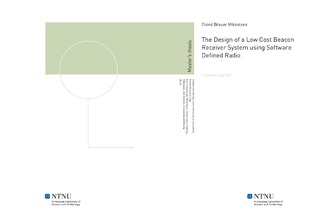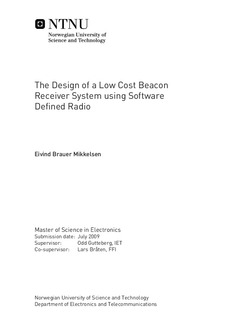| dc.contributor.advisor | Gutteberg, Odd | nb_NO |
| dc.contributor.author | Mikkelsen, Eivind Brauer | nb_NO |
| dc.date.accessioned | 2014-12-19T13:44:25Z | |
| dc.date.accessioned | 2015-12-22T11:42:21Z | |
| dc.date.available | 2014-12-19T13:44:25Z | |
| dc.date.available | 2015-12-22T11:42:21Z | |
| dc.date.created | 2010-09-04 | nb_NO |
| dc.date.issued | 2009 | nb_NO |
| dc.identifier | 348911 | nb_NO |
| dc.identifier.uri | http://hdl.handle.net/11250/2369478 | |
| dc.description.abstract | Due to increase in ship traffic and activities related to oil and gas there is currently grate interest in the northern regions of Norway. Satellite communications to these areas i.e. north of the polar circle is however challenging due to low elevation angles and restricted visibility of geostationary satellites. Limited work has been done to study the propagation effects at theses latitudes and low elevation angles, especially at millimeter frequencies and for maritime communications. Some measurements have been conducted at Svalbard [5] and in Canada [5.1]. The studies from Svalbard were conducted at Ku-band frequencies whilst the Canadian measurements were conducted at 38 GHz. Non of the two did however include maritime measurements. Further measurements are therefore needed to characterize the propagation effects under these conditions. A beacon receiver is radio which is used to detect and measure the signal strength of a transmitted radio beacon signal. Beacon signals transmitted by satellites are often low power continuous wave signals intended for antenna steering and power control purposes. These signals are well suited for propagation measurement due to their constant transmits power and frequency. Propagation research often relies on beacon measurements along with other information such as weather data and radiometer readings. This thesis discusses the design and implementation of a low cost beacon receiver based on digital signal processing techniques and software defined radio. The intention was originally to design a Ka-band (20 GHz) receiver. This was however extended to a general purpose beacon receiver intended to operate at an L-band intermediate frequency. Different architectures and realizations are discussed with emphasis on costs and performance. It is shown that a 1.2 m antenna, receiving a Ka-band beacon with, 9 dBW EIRP would produce a signal level of about -130 dBm at its output. This would in turn yield a C/N0 ratio of about 46 dBHz at 76°North, assuming a receiver with overall noise figure of 1.5 dB and clear air conditions. Based on the link budget calculations two different beacon receiver designs are proposed. One based on the superheterodyne receiver architecture realized with standard RF-components such as mixers and amplifiers with coaxial connectors. The second design is based on the universal software radio peripheral, (USRP), which is a software radio, intended to allow personal computers function as radio transceivers. It was found that building a complete beacon receiver from standard RF-components would require about 100.000 NOK to achieve the wanted performance. This includes a complete system with antenna, front-end and baseband receiver. Due to the relatively inexpensive hardware (4900 NOK) of the USRP and the availability of front-end plug inn boards in the required intermediate frequency range the USRP was chosen as the hardware portion of the receiver. Linearity measurments and observations of the USRP output spectrum shows a linear dynamic range of about 60 dB which is found sufficient for beacon measurements. A Ku-band antenna intended for television reception has been used to receive a 12.2 GHz beacon transmitted by Eutelsat W3A Software code was developed based on the GNU radio framework in order to use the USRP as a beacon receiver. A number of issues were discovered during this work: GNU radio does not contain filters for spectral averaging Attempts to implement additional functionality in software proved challenging due to limitations in computational speed Both of the two issues affected the performance of the beacon receiver. Modifications and additions to the GNU radio software is therefore suggested for future work | nb_NO |
| dc.language | eng | nb_NO |
| dc.publisher | Institutt for elektronikk og telekommunikasjon | nb_NO |
| dc.subject | ntnudaim | no_NO |
| dc.title | The Design of a Low Cost Beacon Receiver System using Software Defined Radio | nb_NO |
| dc.type | Master thesis | nb_NO |
| dc.source.pagenumber | 90 | nb_NO |
| dc.contributor.department | Norges teknisk-naturvitenskapelige universitet, Fakultet for informasjonsteknologi, matematikk og elektroteknikk, Institutt for elektronikk og telekommunikasjon | nb_NO |

